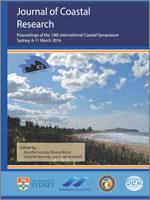Oliver, T.S.N., and Woodroffe, C.D., 2016. Chronology, Morphology and GPR-imaged Internal Structure of the Callala Beach Prograded Barrier in Southeastern Australia. In: Vila-Concejo, A.; Bruce, E.; Kennedy, D.M., and McCarroll, R.J. (eds.), Proceedings of the 14th International Coastal Symposium (Sydney, Australia). Journal of Coastal Research, Special Issue, No. 75, pp. 318–322. Coconut Creek (Florida), ISSN 0749-0208.
Holocene prograded coastal barriers, comprising a sequence of relict foredune ridges, are depositional environments, which have been used to reconstruct coastal processes. Such reconstructions benefit from new techniques and technologies now available in coastal studies. This study investigated the Callala Beach prograded barrier deposit situated within Jervis Bay on the NSW south coast. This prograded barrier, composed of a series of low-relief, shore-parallel ridges, formed after sea level stabilised on this coastline in the mid Holocene. The approach involved analysis of Light Detection and Ranging (LiDAR) topographic data, ground-penetrating radar (GPR) collection and processing, and dating of ridge deposits using the optically-stimulated luminescence (OSL) dating technique. These data sets demonstrate that the most landward ridge of the Callala Beach barrier was deposited ∼7500 years ago, closely aligning with the best estimates for the timing of sea-level stabilisation in southeastern Australia. Progradation continued throughout the late Holocene at a steady rate of ∼0.1 m/yr until near the present time, as shown by an age of ∼400 years immediately behind the modern foredune. GPR-imaged subsurface structures captured the beachface and dune facies; a regular series of reflectors indicated incremental accumulations of sediment over the late Holocene. Volumes of sand accumulated during barrier growth indicated an average sediment supply for the entire embayment of ∼1600 m3/yr or ∼0.3 m3/yr per metre of beach. The long term trend of sediment supply has implications for coastal management as the local council is commencing a beach nourishment program at Callala Beach.





